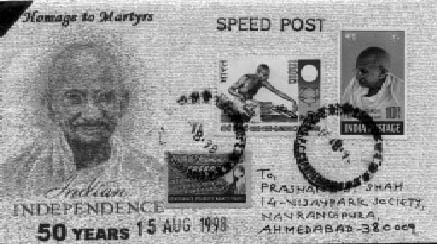Indian Postal History 1947-1997
by Ashok Kumar Bayanwala
13.
1948 August 15, Gandhi ji - The first Indian to be on
stamps of India
|
The 15th August 1948, the 1st Anniversary of India's Independence was commemorated by issuing postage stamps on "Mahatma Gandhiji" in 4 denominations viz., 1? as. 3? as., 12as. and 10 Rupees. The first 3 lower values are in Sepia-brown (Brown), Purple- blue (Violet), Dark-green (Grey -green) respectively. The high value 10 Rupees stamp is in Grey with a Reddish-brown background (Purple-brown and lake). All these stamps were printed in sheets of 50 in 5 rows of 10 stamps each with all around and perforated 11? mm. The top margin has a long inscription extending on 8 stamps, from 2nd to 9th reading "IMRESSION COURVOISER S.A., LA CHAUX - DE - FONDS (SUISSE)". In the bottom margin under the 5th stamp is running number of the sheet and underneath the last stamp is the control number.
The quantity printed and its control numbers are as under:
Initially, these stamps were meant for sale upto 3 months only from the date of issue. But sale of these stamps was extended till 31st December 1948 vide Postal Notice No.50 dated 11th November 1948, because of 55th session of the Indian National Congress, which was held at Jaipur in December 1948. It is reported in January 1949 issue of the Philatelic Journal of India that covers cancelled with 3 different types of postmarks of 55 Congress Session, Gandhinagar, Jaipur, (on these Gandhiji stamps) were sold across the counters of all Philatelic Bureaus in India, at face value plus ? anna for the cover.
Specially designed First Day Covers and Folders were sold for l anna and 3 annas respectively. But, no folder could be sold unless the full set of stamps was purchased at the same time.
The Indian Post and Telegraphs Department made elaborate arrangements for providing commemorative postmark, specially prepared for the day. Even registration was allowed though 15th, August 1948 was a Sunday vide Postal Notice No.32 dated 7th August 1948. It appears that in the history of Postal Administration in India, registration of covers was allowed on Sunday for the first time. These stamps were printed by the Photogravure Process on coated paper made of pulp and silk fibres. Three varieties are known in l ? annas stamp viz.,
|
The Gum used on the backside of the stamps was not at all suitable for the Indian climate, particularly during the season when the stamps were released, when humidity was high. Therefore, when the sheets were taken out of packing and exposed to the atmosphere. They were stuck to the thin interleaving paper. That is to why stamps with original Gum are very scarce and command a premium on existing market rate. These stamps are not intended to be sold in Telegraph Offices, but if any
member of the public finds it convenient to affix them on telegrams, such
telegrams will be accepted, vide DGPO Circular No. 41 dated 7th August 1948.
U Mahatma Gandhi memorial stamps were overprinted 'SERVICE' by offset - Litho at Security Press, Nasik, against Philatelic ethics - to overprint 'SERVICE' on commemorative stamps.
Used examples on covers are unobtainable. Crude forgeries of anna values are found in plenty. These stamps are usually found used with different types of Governor General Camp P.O., cancellations. A very few are known cancelled by President Camp P.O., which is very scarce. The story of making of Gandhi stamps is written by Mr. T. N. Mehta of Indian Postal Administration, is also very interesting as it sketches the true picture of bureaucracy in India. Immediately after Independence, the idea of issue Gandhi Stamp was mooted. On 21st January 1948, the Director General of P & T Dept. requested Security Press, Nasik, to produce Specimen designs for Gandhi Stamps, within a week. The master of India Security Press, suggested issuing a set of 4 Stamps in denominations of lY2annas, 3Y2annas, 8annas and rupee. He proposed that the first 3 Stamps be printed in a single colour in existing 'anna' size and rupee value of Stamp to be printed in two colours in 'rupee' size. Trial copies based on the Em portrait of Gandhiji available with Nashik, was submitted. Alternatively, photographs approved by Mahatma Gandhiji himself could be adopted. While these preparations were going on tragedy struck the Nation, on 30th January 1948. The picture changed drastically and Security Press was asked on 6th February 1948 to prepare Mourning Stamps. On 17th February 1948, the Security Press submitted 2 designs in denomination of 2? annas for Inland Airmail and 12 annas for Airmail to United Kingdom, based on approval sketch drawn by Mr. C. Biswas. The then Prime Minister Sri Jawaharlal Nehru suggested that the word 'Bapu' be included in the proposed stamp designs both in Hindi and Urdu, a symbolic gesture of Communal Harmony, for which Gandhiji laid his life. 10 Rupees denomination was asked on 12th March 1948 and a specimen was submitted on 16th March 1948 by Security Press. Although the proposed stamps were in final stage, the Authorities in New Delhi in a typical bureaucratic manner placed the print order with the well-known Swiss Printers, Helio Curviosier, Sa. La Chaux De Fonds. The Master of Nasik Security Press felt so much that he wanted to quit, but the then Communication Minister Mr. Rafi Ahmed Kidwai argued that India didn't have Photogravure Printing, which the Swiss printers could produce the best result. The irony of bureaucracy is visible -
Bureaucracy could not have done a greater disservice to Gandhiji. Philatelically also, this 10 Rupees stamp deprived the collectors of possessing the full set because 10rupees is a very big amount and unaffordable. Lastly, the clothing of Gandhiji in stamps, in no way approximated the Indian grab or the way Gandhiji used to wear. Actually the photographs showed the Mahatma unclothed above the waist. The bureaucrats thought that it would be derogatory to portray of the 'Father of the Nation' in such a manner. So they asked the Swiss Printers to adequately cover the naked portion of Gandhiji's body, but they couldn't reproduce the Indian Way. Before concluding, I must admit that as Gandhiji used to glitter and eclipsed all other politicians during his lifetime. His 10 Rupee stamp is glittering in Indian stamps and have eclipsed all other Indian stamps. |
|||||||||||||||||
|
|
||||||||||||||||||
|
|
||||||||||||||||||
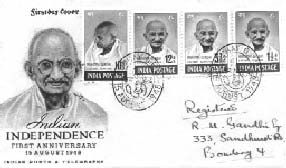
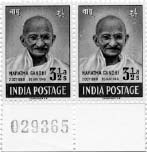
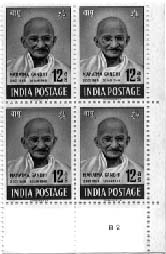


 These commemorative stamps were available from Philatelic Bureaus, set up in
the Principal Post offices in the town of Calcutta, Cuttack, Lucknow, Madras,
Nagpur, New Delhi, Patna, Simla and Shillong with effect from 15th August 1948.
Besides these Philatelic Bureaus, the stamps were available at Bombay (where
Philatelic Bureau was working since 1946) and all Head Post offices and certain
selected Sub Post offices and from the High Commissioner for India in London,
the Indian Embassy in Washington, the Indian Embassy P.O. Nepal and Pondicherry.
(French Territory)
These commemorative stamps were available from Philatelic Bureaus, set up in
the Principal Post offices in the town of Calcutta, Cuttack, Lucknow, Madras,
Nagpur, New Delhi, Patna, Simla and Shillong with effect from 15th August 1948.
Besides these Philatelic Bureaus, the stamps were available at Bombay (where
Philatelic Bureau was working since 1946) and all Head Post offices and certain
selected Sub Post offices and from the High Commissioner for India in London,
the Indian Embassy in Washington, the Indian Embassy P.O. Nepal and Pondicherry.
(French Territory)



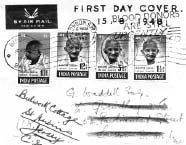
 sually, commemorative stamps are issued in popular postage denomination, but 10
rupees Gandhi stamp is an exception. This high value stamp was used mainly on
Parcels and, Telegrams. Therefore, these used stamps are found either with
'CROSS Cancellation' or 'PUNCH HOLES'
sually, commemorative stamps are issued in popular postage denomination, but 10
rupees Gandhi stamp is an exception. This high value stamp was used mainly on
Parcels and, Telegrams. Therefore, these used stamps are found either with
'CROSS Cancellation' or 'PUNCH HOLES'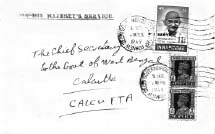
 These overprinted stamps were meant for the use from the Secretariat of the
Governor General H. E. C. Rajagopalachari. Very small quantities were overprinted
and are extremely scarce, both in Mint and used condition. They were printed in numbers are as under:
These overprinted stamps were meant for the use from the Secretariat of the
Governor General H. E. C. Rajagopalachari. Very small quantities were overprinted
and are extremely scarce, both in Mint and used condition. They were printed in numbers are as under:
